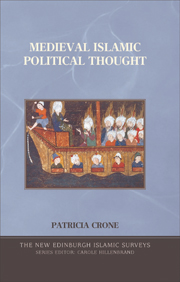Book contents
- Frontmatter
- Contents
- List of charts
- Preface
- Addenda and corrigenda
- I THE BEGINNINGS
- II THE WANING OF THE TRIBAL TRADITION, c. 700–900
- III COPING WITH A FRAGMENTED WORLD
- 12 INTRODUCTION
- 13 THE PERSIAN TRADITION AND ADVICE LITERATURE
- 14 THE GREEK TRADITION AND ‘POLITICAL SCIENCE’
- 15 THE ISMAILIS
- 16 THE SUNNIS
- IV GOVERNMENT AND SOCIETY
- Charts
- Bibliography, abbreviations, and conventions
- Index and glossary
13 - THE PERSIAN TRADITION AND ADVICE LITERATURE
from III - COPING WITH A FRAGMENTED WORLD
Published online by Cambridge University Press: 05 August 2013
- Frontmatter
- Contents
- List of charts
- Preface
- Addenda and corrigenda
- I THE BEGINNINGS
- II THE WANING OF THE TRIBAL TRADITION, c. 700–900
- III COPING WITH A FRAGMENTED WORLD
- 12 INTRODUCTION
- 13 THE PERSIAN TRADITION AND ADVICE LITERATURE
- 14 THE GREEK TRADITION AND ‘POLITICAL SCIENCE’
- 15 THE ISMAILIS
- 16 THE SUNNIS
- IV GOVERNMENT AND SOCIETY
- Charts
- Bibliography, abbreviations, and conventions
- Index and glossary
Summary
The Persian tradition was deeply alien to the early Muslim thought world. In religious terms it took the form of Zoroastrianism, a dualist or indeed polytheist religion which had no prophet or scripture (it took a while for Zoroaster and the Avesta to be adapted to those roles), which expressed itself in mythology and priestly ritual, and which endorsed the oddest of marriage rules and burial customs. Manichaeism struck the Muslims as much more intelligible, for although it used Zoroastrian names, its conceptual world was Judeo-Christian and its message Gnostic. Thus it was usually against Manichaeism rather than Zoroastrianism that Muslim polemics against dualist religions were directed. In political terms, the Iranians glorified the very kingship that the early Muslims regarded as offensive to God, calling their emperor by the blasphemous title of King of Kings (shāhānshāh) and taking pride in their deeply inegalitarian socio-political organization. Even their language was unintelligible, being Indo-European rather than Semitic.
For all that, the Persian tradition rapidly became a key component in Islamic culture. The Arabs conquered the Sasanid empire in its entirety, and eventually subdued the independent principalities of eastern Iran as well, so that the Iranians had no Iranian refuges to flee to. They formed the single largest ethnic group in the caliphate. They were also the only conquered people to have possessed an imperial polity and culture of their own, and they were subdued complete with their aristocracy, the main bearers of their political ideals.
- Type
- Chapter
- Information
- Medieval Islamic Political Thought , pp. 148 - 164Publisher: Edinburgh University PressPrint publication year: 2004



